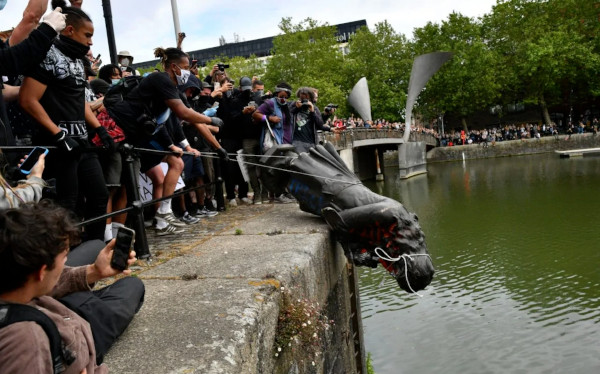
You may have noticed that part of the title is in brackets. In this article, I intend to decipher whether the removal of Imperialist statues diminishes our remembrance of history.
Prior to starting my English and French Combined Honours degree, I was aware of the role that France and England played (as colonisers) in the slave trade- but I had never considered how problematic the ‘evidence’ of their colonising could be.
Admittedly, when I began the FREN114 (Introduction to French Studies) cultural module, I was rather expecting to learn about the different types of wine that France had to offer, perhaps a cheeky wine tasting experience (I am, what the French call, naïve). I was rather taken aback, then, when I was immediately faced with a critical analysis of Pierre Nora’s Les Lieux de Mémoire, which essentially discusses the memorialisation of French identity whilst delving deeper into frame France’s problematic past. A recurring theme throughout the lectures and seminars was whether history and memory can ever be assessed objectively. Symbols are notoriously subjective in that what some see as markers of the past are a stark reminder of centuries of oppression for others.
Cultural contagion
In 2019, the first reporting of COVID-19 was officially cited. For the last two years, the pandemic has caused a ripple effect of devastation that will be felt indefinitely.
Similarly, the Transatlantic Slave Trade began mid-15th century. 600 years on, the symptoms of this longitudinal pandemic are still infecting people. Like the Coronavirus, there has been an incubation period for this social illness. Like wildfire, racist ideologies have spread, and thus bred, into our society.
The removal of statues does not denote an ‘erasure’ of history. Quite the contrary; bringing a sense of retrospective accountability. When BLM (Black Lives Matter) protesters removed statues, confederate ideologies (essentially defending slavery) crumbled at their feet. The removal strives to balance the equilibrium, and combat the long-term ripple effect, that Confederate ideologies have cast over our society. The removal of statues also serves an integral social function, for it reinforces the fact that oppressors will not be rewarded for their transgressions against humanity, essentially eradicating the eradicators.
Oriel College, University of Oxford, admitted just one black student between 2010 and 2015. This coincidentally happens to be the same college that boasts a statue of white supremacist Cecil Rhodes.
Though, it is worth noting that the University of Oxford has put additional measures in place to ensure there is not just equality in their student selection process, but also equity. That is, equality based on one’s individual circumstances. Widening participation schemes such as Target Oxbridge attempt to ‘level the playing field’ for underrepresented state school students.
Setting the scene
However, retaining these statues could serve as a tool of educating people on the injustices inflicted onto indigenous minorities. A placard acknowledging the injustices could open a dialogue, in an attempt to educate western society’s cloistered remembering of history.
Disney+ now feature a content warning as a prelude to some of its best loved films, such as The Jungle Book and The Aristocats (a seemingly harmless film about kittens wandering around Paris), which reads:
‘These stereotypes were wrong then and are wrong now. Rather than remove this content, we want to acknowledge its harmful impact, learn from it and spark conversation to create a more inclusive future together.’
In this statement, Disney attempts to make reparations for their initial conceding of the representations of BAME groups without simply closing the door on the issue. This is, indeed, a very pragmatic solution.
However, the act of having these statues on public display may have a counterproductive effect. Perhaps they would be much better suited in a slavery museum, whereby their role in colonising history could be further contextualised.
Whilst it would be almost impossible to cover this topic in the brevity it deserves, highlighting moments of injustice allows people to acknowledge where history went wrong- but most importantly why history went wrong.
If you want to delve deeper on issues like this, visit the Black History Month reading list on the University of Liverpool website. Here, you will find a range of free and accessible E-books and audiobooks which you can borrow for 14 days.